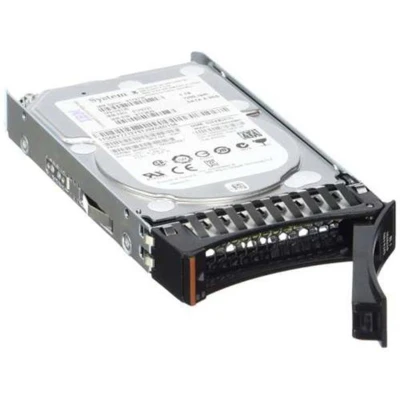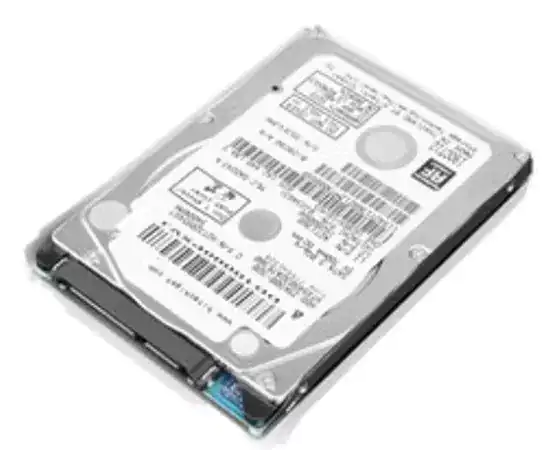Lenovo 00HM913 500GB SATA 6Gb/s 2.5" SFF 7.2K 512e HDD

Shipping $99+
Need new condition?
Click To Chat for current pricing and availablity.
Lenovo 00HM913 Product Specs
| Brand | Lenovo |
| Capacity | 500GB |
| Spindle Speed | 7.2K |
| Interface Type | SATA |
| Data Transfer Rate | 6Gb/s |
| Sector Size | 512e |
| Cache | 16MB |
| Form Factor | 2.5" SFF |
Lenovo 00HM913 Description
The Lenovo 00HM913 500GB SATA 6Gb/s 2.5" SFF 7.2K 512e HDD is a reliable and high-performance hard drive designed for use in Lenovo servers and workstations. Ideal for data storage, backups, and running enterprise applications, this 2.5-inch small form factor (SFF) drive offers compatibility with a wide range of Lenovo server models, ensuring seamless integration and dependable operation. Its SATA interface supports fast data transfer rates of up to 6Gb/s, making it suitable for environments where speed and efficiency are essential.
Key specifications of this Lenovo hard drive highlight its robust features and performance capabilities:
- Brand: Lenovo
- Capacity: 500GB, providing ample storage for critical data and applications
- Spindle Speed: 7,200 RPM, ensuring quick access and data retrieval
- Interface Type: SATA, supporting up to 6Gb/s data transfer rate for high-speed connectivity
- Sector Size: 512e, which enhances compatibility with various operating systems and applications
- Cache: 16MB, improving overall drive performance by buffering data
- Form Factor: 2.5" Small Form Factor (SFF), ideal for compact server designs
For maintenance and replacement purposes, the following Lenovo spare part numbers correspond to this hard drive model, ensuring you can find the right parts quickly and easily:
- Lenovo 04W0583 (Part Number: 04W0583)
- Lenovo 00HM734 (Part Number: 00HM734)
- Lenovo 00HM721 (Part Number: 00HM721)
- Lenovo FRU00HM715 (Part Number: FRU00HM715)
- Lenovo FRU04X0927 (Part Number: FRU04X0927)
- Lenovo 01AW513 (Part Number: 01AW513)
- Lenovo 00UP278 (Part Number: 00UP278)
- Lenovo 00UP376 (Part Number: 00UP376)
- Lenovo 00HN444 (Part Number: 00HN444)
- Lenovo 04X0927-06 (Part Number: 04X0927-06)
- Lenovo 04W1981 (Part Number: 04W1981)
- Lenovo 00HM715 (Part Number: 00HM715)
- Lenovo 04X5963 (Part Number: 04X5963)
-
Payment Options

All Credit Cards Accepted + PayPal

PO Accepted from Qualified Businesses and Government Entities
Delivery Options
Overnight and Express Delivery in USA
Get within 1 to 3 days
Free Ground in USA
2 to 6 days (Varies by location)
$49 Ground Shipping To Canada
International Delivery Options Available
Contact Us For Detail
Return & Warranty
30 days return
Warranty vary by product please see our Policies page
Trusted by 5000+ IT Managers, System Integrators & Data Center Experts


Easy Returns
"We purchased the wrong part by mistake. Boost hardware made it easy to return and quickly issued me a refund.""

Lowest Price By Far
"We were able to purchase 10x HP 782995-001 for 25% less than the next lowest price. Very impressed with the quick shipping and lack of issues."

Excellent Customer Service
"Excellent customer service; they got in touch with me right away. They upgraded my next order to free 2-day shipping."

![]() We found 20 subs for the Lenovo 00HM913
We found 20 subs for the Lenovo 00HM913

- Spindle Speed: 7.2K
- Capacity: 500GB
- Interface: SATA
- Form Factor: 2.5" SFF
- Cache: 16MB
- Brand: Lenovo
- Data Transfer Rate: 6Gb/s
- Sector Size: 512e

- Spindle Speed: 7.2K
- Capacity: 500GB
- Interface: SATA
- Form Factor: 2.5" SFF
- Cache: 16MB
- Brand: Lenovo
- Data Transfer Rate: 6Gb/s
- Sector Size: 512e

- Spindle Speed: 7.2K
- Capacity: 500GB
- Interface: SATA
- Form Factor: 2.5" SFF
- Cache: 16MB
- Brand: Lenovo
- Data Transfer Rate: 6Gb/s
- Sector Size: 512e

- Spindle Speed: 7.2K
- Capacity: 500GB
- Interface: SATA
- Form Factor: 2.5" SFF
- Cache: 32MB
- Brand: Lenovo
- Data Transfer Rate: 6Gb/s
- Sector Size: 512e

- Spindle Speed: 7.2K
- Capacity: 500GB
- Interface: SATA
- Form Factor: 2.5" SFF
- Cache: 32MB
- Brand: Lenovo
- Data Transfer Rate: 6Gb/s
- Sector Size: 512e

- Spindle Speed: 7.2K
- Capacity: 500GB
- Interface: SATA
- Form Factor: 2.5" SFF
- Cache: 16MB
- Brand: Lenovo
- Data Transfer Rate: 6Gb/s
- Sector Size: 512e

- Spindle Speed: 7.2K
- Capacity: 500GB
- Interface: SATA
- Form Factor: 2.5" SFF
- Cache: 16MB
- Brand: Lenovo
- Data Transfer Rate: 6Gb/s
- Sector Size: 512e

- Spindle Speed: 7.2K
- Capacity: 500GB
- Interface: SATA
- Form Factor: 2.5" SFF
- Cache: 16MB
- Brand: Lenovo
- Data Transfer Rate: 6Gb/s
- Sector Size: 512e

- Spindle Speed: 7.2K
- Capacity: 500GB
- Interface: SATA
- Form Factor: 2.5" SFF
- Cache: 16MB
- Brand: Lenovo
- Data Transfer Rate: 6Gb/s
- Sector Size: 512e

- Spindle Speed: 7.2K
- Capacity: 500GB
- Interface: SATA
- Form Factor: 2.5" SFF
- Cache: 32MB
- Brand: Lenovo
- Data Transfer Rate: 6Gb/s
- Sector Size: 512e

- Spindle Speed: 7.2K
- Capacity: 500GB
- Interface: SATA
- Form Factor: 2.5" SFF
- Cache: 16MB
- Brand: Lenovo
- Data Transfer Rate: 6Gb/s
- Sector Size: 512e

- Spindle Speed: 7.2K
- Capacity: 500GB
- Interface: SATA
- Form Factor: 2.5" SFF
- Cache: 32MB
- Brand: Lenovo
- Data Transfer Rate: 6Gb/s
- Sector Size: 512e

- Spindle Speed: 7.2K
- Capacity: 500GB
- Interface: SATA
- Form Factor: 2.5" SFF
- Cache: 16MB
- Brand: Lenovo
- Data Transfer Rate: 6Gb/s
- Sector Size: 512e

- Spindle Speed: 7.2K
- Capacity: 500GB
- Interface: SATA
- Form Factor: 2.5" SFF
- Cache: 32MB
- Brand: Lenovo
- Data Transfer Rate: 6Gb/s
- Sector Size: 512e

- Spindle Speed: 7.2K
- Capacity: 500GB
- Interface: SATA
- Form Factor: 2.5" SFF
- Cache: 32MB
- Brand: Lenovo
- Data Transfer Rate: 6Gb/s
- Sector Size: 512e

- Spindle Speed: 7.2K
- Capacity: 500GB
- Interface: SATA
- Form Factor: 2.5" SFF
- Cache: 16MB
- Brand: Lenovo
- Data Transfer Rate: 6Gb/s
- Sector Size: 512e

- Spindle Speed: 7.2K
- Capacity: 500GB
- Interface: SATA
- Form Factor: 2.5" SFF
- Cache: 32MB
- Brand: Lenovo
- Data Transfer Rate: 6Gb/s
- Sector Size: 512e

- Spindle Speed: 7.2K
- Capacity: 500GB
- Interface: SATA
- Form Factor: 2.5" SFF
- Cache: 32MB
- Brand: Lenovo
- Data Transfer Rate: 6Gb/s
- Sector Size: 512e

- Spindle Speed: 7.2K
- Capacity: 500GB
- Interface: SATA
- Form Factor: 2.5" SFF
- Cache: 16MB
- Brand: Lenovo
- Hot-Swappable: No
- Data Transfer Rate: 6Gb/s
- Sector Size: 512e

- Spindle Speed: 7.2K
- Capacity: 500GB
- Interface: SATA
- Form Factor: 2.5" SFF
- Brand: Lenovo
- Data Transfer Rate: 6Gb/s
- Sector Size: 512e
- Cache: 16MB
Customer Reviews
Availability
New Condition: Chat For Price
Delivery Options
Overnight and Express Delivery in USA
Get within 1 to 3 days
Free Ground in USA
2 to 6 days (Varies by location)
$49 Ground Shipping To Canada
International Delivery Options Available
Contact Us For Detail
Payment Options
All Credit Cards Accepted + PayPal
PO Accepted from Qualified Businesses and Government Entities
Return & Warranty
30 days return
Warranty vary by product please see our Policies page

